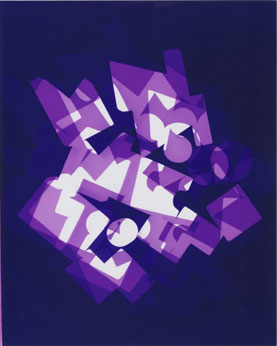9.2.24 — Part-Time Silent Comedian
Yto Barrada photographed Gibraltar, near her African home town, as a touch point for North Africans in the treacherous passage to safety. She embraced it, too, for the sun and sea.
YThat was 1999, but even now she is traditional enough to work not digitally, but in the darkroom. At the International Center of Photography, you may wonder if she ever leaves its confines, even with a camera. She prefers photograms, of candy wrappers and child’s toys, as a cavalcade of overlapping colors and blocks of light. Sweet. 
You may not think of Barrada as a photographer, but she began as one. She graduated from the one-year programs at ICP in 1996—then in a Fifth Avenue mansion that could have converted anyone to the medium. Now she returns home several times over. She was back in the darkroom ten years ago, on her return to New York, and she has a solo show at her old school of the results, while recent graduates of those programs share their work a floor above. It may not define her once and for all, but it helps broaden the museum’s self-definition. She may never become a full-time photographer, but she is, as the show has it, “Part-Time Abstractionist,” through September 2.
Actually Barrada has had several homes and successive media. Born in Paris to Moroccan parents in 1971, she spend much of her childhood in Tangier, studied at the Sorbonne, and co-founded a cinema art house in Tangier as well. She exhibited at the LMCC Art Center on Governors Island in 2020, with Bettina Grossman (or simply Bettina) as her guest. Her work there included sculpture, installation, and abstract art (and I leave you to my review then for more). Now she brings a long overdue touch of color to the barren, pebbled courtyard of MoMA PS1. The piled cubes of Le Grand Soir look like attempts at grand pyramids that never quite made it—or just long overdue seating.
ICP displays sculpture and video, too, in a small show curated by Elisabeth Sherman. A makeshift vase holds cardboard flowers, while the video takes her from the darkroom to an arid but tempting suburban landscape. Cars with what might be a hearse at its front pass homes whose only face rotates open and shut, like an oversize garage door. The procession reaches a traffic circle without heeding the temptation to turn, on its way to what must remain unseen and unknown. As the cars pass, red and white striped curbs swell into red along the pavement, and palm trees sink into the ground and rise once more. They, too, are part-time abstraction.
Are they playful in tone, formal exercises, or deeply allusive—much as the houses might pass for toys, Minimalist sculpture, or the American southwest? Do they belong at all at ICP? Whatever your answer, do not be too sure. The year’s celebration of “ICP at 50” recalled its founding mission, to promote photojournalism and a concern for humanity. Barrada earned her certificate in documentary photography as well. Yet ICP’s anniversary show also saw a broadening as far as abstraction, and so does she.
Barrada does not need a camera to approach the heights of abstraction. She relishes darkroom tools, like dodge and burn, and rescues paper from the trash. A sewing machine without thread punches its way through more paper, leaving first vertical and horizontal axes, then parallel lines between them. By the time she is done, she has a near textbook reproduction of a black painting by Frank Stella. In the one series with a camera, plumbing supplies from Tangier look like actors in a silent comedy. Take it seriously, but keep smiling.
Read more, now in a feature-length article on this site.